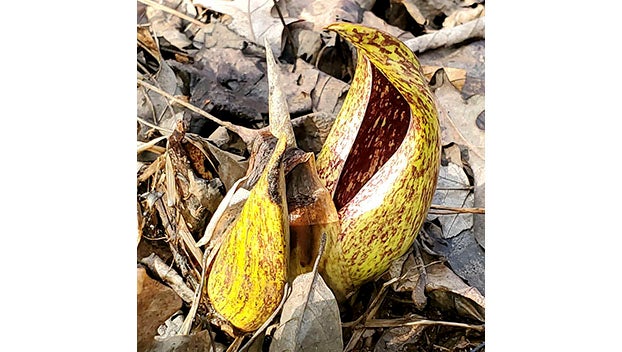Mother Nature’s Garden: The Skunk Cabbages are back
Published 12:54 pm Saturday, February 25, 2023

- These two skunk cabbages have been slightly damaged by unusually cold weather, but they’re still standing tall, and leaves are beginning to emerge.
|
Getting your Trinity Audio player ready...
|
“If you are afflicted with melancholy at this season, go to the swamp and see the brave spear of skunk-cabbage buds already advanced toward a new year…See those green cabbage buds lifting the dry leaves in that watery and muddy place. There is no can’t or cant to them. They see over the brow of winter’s hill…The most prepared for spring — to look at — of any plant.” — 1857 entry in Henry David Thoreau’s diary.
Yes, it’s that time of the year again. The skunk cabbages (Simplocarpus foetidus) are back. If you know where to look, you can find their purple or yellow spathes pushing up through muck and mire. Even through snow in a particularly cold year.
People often ask me why I love this plant. After all, it grows in wet, swampy places, it’s not particularly pretty, and, yes, it emits an intriguing scent of skunk with undertones of rotting meat. There are many reasons to admire skunk cabbage. It’s a very old plant that’s probably been around since the Cretaceous period, roughly 145.5 to 65.6 million years ago when Tyrannosaurus rex was alive. It’s a survivor that’s well adapted to its environment. In our area, the skunk cabbage emerges when it’s still cold outside — in late December, January, or perhaps in February — and still manages to bloom, attract pollinators, and produce seeds.
For over 50 years, scientists have known that the skunk cabbage is thermogenic, meaning that it can generate heat to maintain a temperature inside its spathe that’s higher than that of the surrounding ambient air. For example, if the outside temperature is 37F, the temperature inside the spathe may be a toasty 60F degrees.
More recent research by scientists at Iwate University in Morioka, Japan, has revealed details about the process. The heat is produced by mitochondria in cells in the florets on the spathe. Rather than fueling growth, they generate heat. The warmth gives the skunk cabbage a competitive advantage during harsh late winter/early spring weather. It encourages pollination, protects flowers from freezing, and helps disperse the unique skunky scent that attracts pollinators searching for carrion.
There are many reasons for admiring the skunk cabbage. It’s ancient; it has unique survival mechanisms; but most important of all, it’s a tough little plant that inspires confidence that spring will soon arrive.
Dr. Cynthia Wood is a master gardener who writes two columns for The Herald. Her email address is cynthia.crewe23930@gmail.com.





